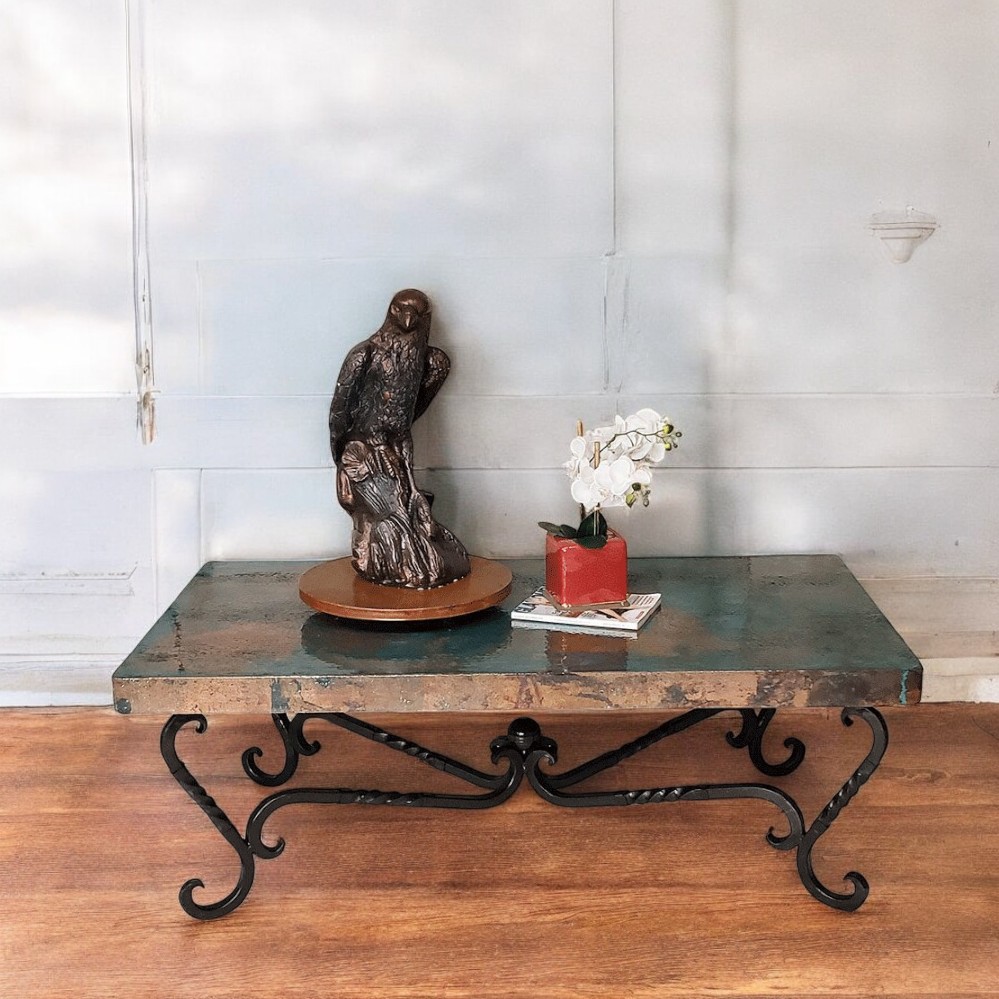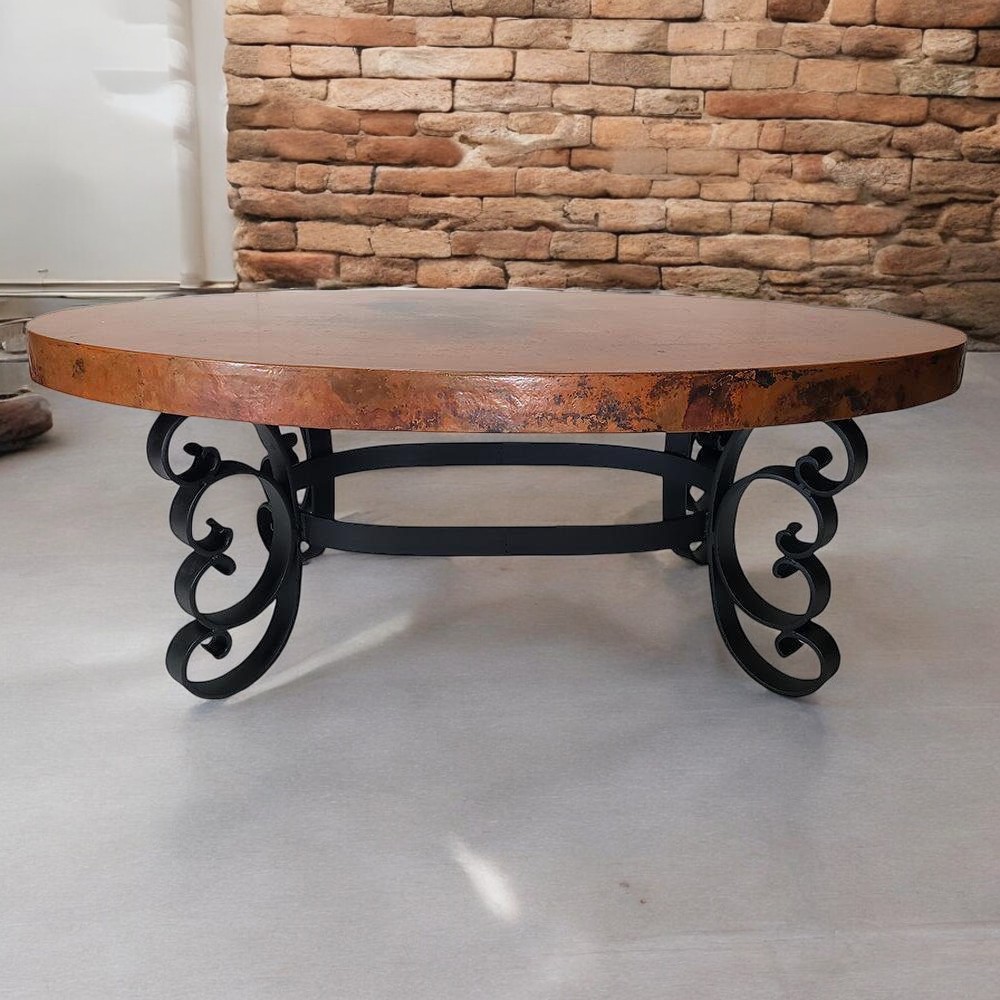Welcome to the world of Mexports, where our beautiful Hammered Copper Tables turn rooms into works of art. These aren’t just tables; they’re works of art made by the best Latin fine furniture Designers. They’ll add a touch of class and elegance to your home.
Our hammered copper coffee tables are made with real copper, heated, hammered, and aged by hand, then paired with solid, hand-forged iron bases. These aren’t factory pieces. Each one is made to order, shaped around your space, and designed to last. You’ll feel the quality. And you’ll know it was made just for you.
Filter by price
Color
Materials
Product Status
Best-Selling Rectangular Coffee Table with Natural & Oxidized Copper Top
$5,519.00This Incredible Top Seller Copper Rectangular Coffee Table has a Mediterranean style and is eco-friendly. Exquisite one-inch thick solid wrought iron base with a rusted finish. Enjoy your hot and cold beverages in the most stylish, elegant manner!
Bestseller Hammer Copper Oval Coffee Table -Iron tables
$4,599.00The oval shaped pure copper top is conscientiously hand hammered by the ace artisans which gives it an individualized texture that will be second to none. The rustic appearance of the artfully hand beaten oval top will mesmerizingly embellish any room you assign the table to. This is one of those artsy tables which gorgeously complement a variety of interiors. Copper, which is cherished for exhibiting antimicrobial properties, gives the table an astonishing aspect that will be accoladed unanimously by your acquaintances.
CONTEMPO Rectangular Coffee Table: Industrial Charm with a Hammered Metal Iron Base
$4,599.00This Rectangular Coffee Table with Hammer Metal Industrial Iron Base is a modern and contemporary design. Combines the timeless look of hammer copper top with contemporary metal sheet base lines design, which makes it a unique and select piece.
Contemporary Coffee Table – Elegant & Functional Living Room Accent
$5,519.00European Designs inspired this Contemporary Copper Square Table for the Living Room. With centuries of old metalworking tradition, our gifted craftsman creates our hand-hammered copper table tops. For years, we have been improving our hand-hammered coppers to offer you original styles of this metal.
Checkout our popular collection:
Contemporary Oval Copper Coffee Table – Handcrafted with Oxidized Hammered Top
$5,519.00This Rectangular Coffee Table with Hammer Metal Industrial Iron Base is a modern and contemporary design. Combines the timeless look of hammer copper top with contemporary metal sheet base lines design, which makes it a unique and select piece.
Contemporary Oval Copper Coffee Table with Hammered Top – Elegant & Handcrafted
$4,599.00This Contemporary Hammer Top Oval Copper Coffee Table, and hand forged iron base, is a fiery and lustrous charm to incorporate into your space!
The marvelous chocolate espresso iron finish escalating the excellently crafted artistry of the table making it an essentially striking and conspicuous selection to incorporate in your space.Happy shopping
Contemporary Oxidized Copper Square Table for the Living Room –
$5,519.00European Designs inspired this Contemporary Copper Square Table for the Living Room. With centuries of old metalworking tradition, our gifted craftsman creates our hand-hammered copper table tops. For years, we have been improving our hand-hammered coppers to offer you original styles of this metal.
Contemporary Round Coffee Table with Oxidized Hammered Copper Top & Iron Base
$4,049.00 – $5,519.00This Sophisticated Contemporary Round Coffee Table features an oxidized hammered copper top and a sturdy iron base, blending modern elegance with rustic charm.
Contemporary Style Round Coffee Table with Hammered Copper Top
$3,359.00 – $4,599.00This Round Coffee Table with hammered copper top and wrought iron base is for you, if you want something out of the ordinary. It has a beautiful wavy base, which gives it a unique and distinctive touch. The copper finish can be natural or oxidized, to give it a more exclusive touch.
Deluxe Round Coffee Table with Natural Copper Top & Scrolled Iron Legs
$3,359.00 – $4,599.00This Deluxe Round Copper Coffee Table with Scrolls on the Legs is the perfect finishing element for your living space. Exhibits natural hints of oxidized zones that radiate a warm glow and tantalize your senses.
Designer Hammered Copper Rectangular Coffee Table with Oxidized Top
$5,519.00Combine elegance with a contemporary twist with this Design Hammer Copper Rectangular Coffee Table, reminiscent of that pleasant moment!
Elegant Hammer Copper Square Coffee Table with Iron Pedestal
$5,519.00The Elegant Hammer Copper Square Coffee Table, with Iron Pedestal, was designed exclusively for the High End Client. Enjoy the same timeless look and durability in your living space. The hammer copper square-shaped top merges sublimely well with the impeccably suited curvy iron legs.
Shapes for Every Space
All homes are unique, and we understand that, which is why we do copper coffee tables in 4 shapes:
Rectangular, Round, Square, and Oval.
From the largest living room to the smallest of cozy corners, we have just the shape for you. Each table features a durable wrought iron base and solid copper top, so you know it will last for decades.
Want Something Custom?
Need a different size or finish? No problem. At Mexports, everything is handcrafted, so we’re happy to build a table that fits your space perfectly. Just tell us what you have in mind, and we’ll make it happen, from the shape to the patina to the table height.
→ Contact us today to start your custom coffee table design.
With love,
Susana Molina
Founder & Designer, Mexports Inc.












